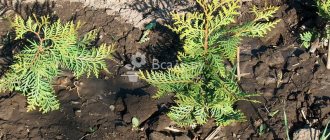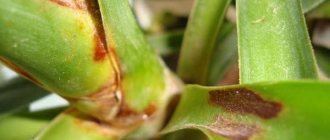Roses are capricious flowers that not only require increased attention during the flowering period, but also need special protection in winter. Rose bushes are covered for the winter, but it often happens that after wintering the plants turn black or dry out. What to do in this case to save the flowers?
Immediately after removing the cover, the plants should be carefully examined to assess the extent of the damage. In most cases, it is enough to simply carry out sanitary pruning, water and feed the roses with special means. The article will tell you how and when it is best to do this.
- Vodka
How to save roses after an unsuccessful winter
If the rose has not woken up after winter, a number of measures should be taken immediately:
- Collect all old leaves from bushes and ground. Inspect the bush and use pruning shears to remove dried, broken, frost-damaged stems.
- Cut blackened shoots back to healthy wood. Cut completely damaged plants with an intact graft to the grafting site on the trunk - there is a possibility that dormant buds will wake up and young shoots will appear.
- Lubricate the cut areas with brilliant green, and then with garden varnish or a special paste.
- Water the soil and spray the roses with a fungicide, such as Bordeaux mixture or Fundazol.
- Plants should be shaded or covered. Large-capacity cut plastic bottles painted white are suitable for these purposes. It turns out to be a small greenhouse in which comfortable conditions are created for the restoration of the rose.
- Mulch the soil around the bush.
- Throughout the entire period of resuscitation, carry out regular moderate watering. The soil should not dry out or be waterlogged.
Even seemingly hopeless plants can awaken
If these steps are performed on time in the spring, then the problem of how to revive roses after winter will quickly disappear.
Note! If the cause of an unsuccessful wintering was errors in care, it is important to correct them.
How to prevent rapid fading?
To avoid having to revive flowers when they wither, you need to provide proper care from the very beginning. Here are some useful tips:
- Trim the end of the stem a little every day. The procedure will refresh capillaries clogged with air and restore the flow of nutrients.
- It is advisable to peel about 5 cm of the stem from the hard peel. This will also improve the nutrition of the flower.
- Remove leaves and shoots at the bottom of the branch - only the stems should be in the water.
- Change the water and wash the vase daily. Remember, roses only love settled water.
- Disinfect the water using activated carbon or a drop of detergent.
How to revive a rose with blackened stems
When figuring out why roses turn black in the spring and do not wake up, you should not get rid of them, but revive them. Varietal specimens are capable of awakening even if they are completely devoid of shoots. If the roots remain viable, young shoots can come from them and the rose will gradually grow in the above-ground part.
Thuja turned yellow after winter - what to do, how to treat and how to fertilize
If small blackened areas are visible on the shoots, then they should be cut along healthy tissue so that the cut site is located 5 mm above the bud. It should be smooth, with a slight slope, without jagged edges or torn edges.
Note! It is impossible to shorten stems along dead tissue, as this leads to rotting and death. It is important to immediately disinfect the wound and cover it with garden varnish.
Shoots that are completely blackened must be removed. They are pruned to the grafting site so that no stump remains. All stems located below the graft must also be cut off. Otherwise, the flowers will not retain their varietal characteristics.
Gardeners often wonder: if roses disappear in the garden, what to do and how to determine whether the blackened bushes are alive. You should trim them and monitor their condition. If the roots survive and buds remain, then after some time young shoots will appear, and then a full-fledged crown will form. Roses are considered a fairly hardy crop; they are able to survive even radical pruning, recover and bloom.
After cutting, the bushes need to be fed
Cold and moisture – we create ideal conditions!
Another excellent tool for revitalizing roses is cold. To make the flowers fresh and last for more than one day, you need to wrap the bouquet with a wet towel, then wrap it in newspaper and put it in the refrigerator. Preferably on the second shelf from the freezer so that the petals do not freeze. Of course, the procedure can be carried out literally every few days. Otherwise, the flowers may begin to rot and deteriorate. Don’t even think about putting the bouquet in sub-zero temperatures, otherwise, after returning to the warmth, it will instantly wither!
Reasons why a rose turns black after wintering
The reasons that force you to decide how to revive rose bushes with blackened shoots often lie in improper organization of care. If you do not properly prepare plants for wintering in the fall, they may darken and die.
Why do hydrangea leaves dry around the edges - what to do and how to revive the flowers
If on the eve of cold weather the bushes were covered with special material, then with the onset of spring it is important to remove it in a timely manner. This can only be done after the threat of frost has passed.
Note! During the summer months, roses also sometimes need to be covered. This is a necessary measure of protection from direct sunlight and rot.
Marsonina
This is one of the most harmful diseases of indoor and garden crops, which cannot be treated for a long time. Its other name is black spotting. It is provoked by the fungus Marssonina rosae and appears on leaf blades and shoots. They first acquire purple-white spots and then black ones. The foliage turns gray-brown and falls off. Weak plants from marsonina wither and hardly bloom, and do not tolerate wintering well.
It is difficult to avoid the appearance of fungus on roses, but strengthening the plant’s immunity is not difficult. This helps them resist the pathogen. It lives in alkaline soil, old fallen leaves, and is brought by wind and precipitation.
Factors that contribute to the spread of the fungus and must be eliminated are:
- high humidity;
- damp and warm weather;
- sudden changes in humidity and drought;
- excessive watering;
- lack of lighting.
Powdery mildew
Powdery mildew is a fungal disease. Spores of the pathogen Sphaeroteca pannosa live in the soil for decades and become active under favorable conditions:
- high humidity;
- heat;
- excess nitrogenous substances in the soil.
Roses are often susceptible to powdery mildew when the branches thicken. Young shoots and petioles are the first to suffer. They become covered with a white coating. When the spores mature, droplets of liquid are released and ulcers appear. The leaves turn yellow, the buds become smaller and stop blooming.
Over time, the stems may become bare and covered with plaque.
Factors that provoke fungal infection:
- rainy weather;
- high humidity;
- sudden temperature changes;
- excess nitrogen content in the soil;
- mineral deficiency.
Infectious burn
Caused by fungal spores, it often develops with the onset of spring after roses are released from their shelters. It occurs mainly due to dampness, which is installed under covering materials, especially at positive temperatures.
Main works
One of the most difficult tasks is to correctly determine the deadlines for completing certain works. We suggest you follow step-by-step instructions, compiled taking into account the recommendations of experts and allowing you to figure out how to care for roses in the garden in the spring.
Removing covers
The first stage is the removal of protective covers after wintering. These works should not be started too early, but you should not delay them either, since premature opening threatens freezing, and later can lead to damping off of the bushes. Experienced gardeners advise removing the protection in stages. The optimal timing for each region depends on the climate, so you need to focus on the air temperature, the degree of soil heating and the weather forecast for the next few days.
First, you need to remove the remaining snow from the shelter and make drainage grooves to prevent stagnation of melt water in the root zone
As a rule, in the Moscow region and central Russia, roses begin to partially open in mid-late March. At first, the protective structures are opened on both sides only for half an hour in order to refresh the microclimate and carry out a little ventilation. If the snow cover has almost melted and the weather is warm, the shelter on one side does not need to be closed.
After 7-10 days, re-ventilation is carried out. If weather conditions permit, the plants are left open on both sides. After another week, it is recommended to slightly open the protective layer on the north or east side. When 2-3 days have passed and the plants have adapted a little, they are opened completely.
In the Moscow region and the middle zone, the optimal time for completely freeing roses from protective structures is April 10-20, in the Urals - April 15-25, in Siberia - April 20-30. The protection should be completely removed only if the average daytime air temperature reaches 15 ℃, and the soil has thawed to a depth of 35-50 cm. It is better to carry out work in the evening or on a calm, cloudy day; care should also be taken that the plants are not damaged in the future by bright sun and shade them for a while with a thin layer of any non-woven material.
Trimming
The next stage in caring for decorative perennials is sanitary pruning. It is recommended to start it approximately 3-7 days after opening the bushes, so that they adapt a little to fresh air, but not later than the moment when the buds begin to bloom. All dry, broken, frozen and diseased shoots are removed from plants.
For sanitary purposes, remove all shoots that show signs of damage from frost, diseases and pests.
When pruning adult bushes, the need for thinning and rejuvenation is also taken into account. If the branches grow too densely, there is a possibility of poor air circulation, which increases the risk of fungal diseases. Therefore, it is advisable to remove thin and weak shoots, as well as those that grow inside the crown. In most modern varieties, branches that have reached 3-4 years of age are considered old, since few flower buds are formed on them, and they look less decorative compared to young ones. Such branches are thicker and covered with dark, woody bark. They need to be removed to stimulate the growth of new shoots.
To maintain a harmonious appearance of the bushes, formative pruning is carried out, shortening the remaining healthy branches:
| Garden group | The degree of shortening of shoots | Periodicity |
| Hybrid tea | 1/3 | Annually |
| Floribunda | 1/3 | Annually |
| Climbing | From 3 to 5 buds are left on the side shoots | Annually |
| Ground cover | Up to a length of 20-30 cm | Every 4-5 years |
On grafted bushes, wild shoots growing from the rootstock must be removed. They can be distinguished by several characteristics: a complex leaf consists of seven leaflets, they are smaller than those of cultivated varieties, have an elongated shape and light green color, grow below the grafting site, and there are many thorns on the stems. Such growth must be cut off completely or broken out at the base.
All types of pruning are performed with sharp pruning shears, which are wiped with a disinfectant. The cuts are made at an angle of about 45 degrees and about 0.5 cm above a healthy bud, directed outward and not inward of the bush. All cuts should be treated with garden varnish to prevent infection from entering the plant tissue.
Treatment against diseases and pests
Before the buds swell, it is necessary to carry out preventive spraying. This is especially important if in the previous season the plants showed signs of fungal and other diseases or pest damage. For processing, copper sulfate is usually used, which is diluted in water (100 g per 10 liters).
Plants are treated with solutions of fungicidal and insecticidal preparations or “folk” remedies
Products made from plant materials, such as horsetail, wormwood, nettle, tansy and others, are considered less harmful. According to gardeners, an infusion of horsetail helps fight rust, powdery mildew and spider mites.
Experts advise making an infusion of horsetail as follows:
- 150 g of dry herb is poured into an enamel container and poured 10 liters of cold water;
- insist for a day;
- cover the container with a lid and cook for 30 minutes over low heat;
- remove the lid and wait until the infusion has cooled completely;
- filter into a plastic or enamel container.
The resulting infusion can be stored for 2 weeks. For spraying, it is diluted with water in a ratio of 1:5. It is better to carry out processing in the early morning on warm, windless days.
Ready-made biofungicides and herbal remedies can also be purchased in specialized stores. In this case, you must act according to the instructions on the package.
Top dressing
In spring, it is important to fertilize plants with mineral and organic fertilizers. At the end of April, it is recommended to feed roses with nitrogen-containing preparations or complex fertilizer, which includes the main necessary elements: nitrogen, phosphorus and potassium.
To stimulate active growth, organic matter or mineral complexes with a high nitrogen content are used
To make nitrogen fertilizer, take 10 liters of water and 1 tablespoon of ammonium nitrate or urea. The resulting solution is watered at the roots of the plants. These fertilizers can also be applied in dry form - 1 tablespoon is poured under the bush, then the soil is loosened and watered generously.
Fertilizing with complex fertilizer gives good results. In modern gardening stores there is a large assortment of various preparations developed specifically for roses. They are used in accordance with the instructions.
About a week after the first feeding, it is advisable to fertilize the soil with organic matter, for example, rotted manure or compost. To do this, make a depression around the bush at a distance of approximately 15-20 cm from the center. Half a bucket of organic matter is poured into it, the soil is loosened well, and then watered abundantly. Fresh manure should not be used as it can burn the roots.
Mulching
In May, after the plants have been pruned and fertilized and the soil has warmed up sufficiently, it is recommended to mulch. This will protect the soil from hypothermia and overheating, help retain moisture, increase fertility and slow down the growth of weeds.
Due to the mulch layer, you can create additional decorative effects on the site
Peat, rotted manure, crushed tree bark, sawdust, pine needles, leaf humus, grass clippings, nut shells, and garden compost are used as mulch. The cut grass must first be dried in the sun for several days, otherwise it may rot, which will adversely affect the condition of the soil. A mulch layer 5-8 cm thick is poured around the bush, slightly away from the center. Before this, the soil is well loosened, weeds are removed and watered.
In the fall, mulch can be mixed into the soil, which will help improve structure and increase fertility. If mulching is carried out regularly, then from time to time the old layer must be raked, weeds that have grown under it must be weeded, the soil loosened, and then replaced with a fresh layer.
Planting new bushes
At the beginning of the season, there is a large selection of planting material, including those brought from leading European nurseries. As practice shows, roses planted in spring have time to take root well and prepare for winter.
Planting begins when the soil has completely thawed and warmed up to 10...12 ℃, and the daytime air temperature will remain at 15...16 ℃. In central Russia and the Moscow region, the optimal period is considered to be from the second half of April to the beginning of May; in the Krasnodar Territory you can plant bushes from the end of March, and in Siberia and the Urals - from the beginning to mid-May.
Fertile loamy soil is well suited for roses; sandy and clay soil needs improvement
It is advisable to prepare the planting site in advance, before the seedlings are purchased. The best areas are those that are well lit by sunlight, located at a slight elevation, and protected from cold northern winds and drafts.
The planting hole is dug with a depth and diameter of 40-50 cm, the volume of the hole must correspond to the size of the horse system and exceed it by 15-20 cm. During work, the top fertile layer of soil is poured separately from the bottom. It is recommended to add 10 g of potassium fertilizer, 25 g of superphosphate and approximately 8 kg of rotted manure to the fertile soil. All components are thoroughly mixed and soil is added from the lower layer - in the end you should get as much soil as is needed to fill the planting hole.
Purchased seedlings are released from packaging, inspected and damaged shoots and roots are trimmed to healthy tissue. The branches are shortened: on hybrid tea varieties to 2-3 lower buds, on floribundas to 3-4 buds, on scrubs, groundcovers and climbing varieties they cut off very little. For seedlings with an open root system, roots that are too long are shortened to about 35 cm, and the rest are trimmed slightly to activate them.
The seedlings are first kept for several hours in a bucket of water, to which growth stimulants are added.
A drainage layer is laid at the bottom of the planting hole, then a previously prepared fertile soil mixture is poured, forming a small elevation - a mound. The plant is placed on it and the roots are straightened, while you need to ensure that in grafted plants the grafting site is 3-4 cm below the soil surface. The roots are gradually covered with soil. To ensure that it is distributed evenly, the seedling is shaken periodically. After planting, the soil is compacted a little, a groove is formed around the bush and watered with a bucket of water.
For the first time, it is recommended to cover the above-ground part of the seedling with an inverted pot, a dark plastic bottle, or hill it up to its full height with soil or mulch. When young leaves appear, the shelter can be removed. It is better to do this on a cloudy day or in the evening.
What to do if the rose does not wake up
Rose leaves in a hole - what to do about the problem
Gardeners often don’t know what to do if roses don’t wake up after winter. During this period, the roots and buds of the plant suffer from lack of air and may become stubborn. The bushes enter the stage of active growth, but may die due to a stop in the development of the root system. It is this reason that raises the question of how the rose root can be revived.
Why does this happen, how to wake it up
Grafted roses have difficulty reviving after a period of dormancy. In March, the buds begin to swell on them. The bushes are preparing to grow. But they lack sun and lighting. In addition, the root system freezes in the soil. For this reason, plants need to be awakened. To do this you should:
- Organize ventilation by digging out the shelter and removing the plastic film from opposite sides.
- Pierce the material with a knife so that air penetrates under the shelter from above.
- When the air temperature reaches +8 degrees, the roses must be completely freed.
- Protect from direct sunlight.
- Pour over warm water.
- Loosen the soil.
- Before the buds open, spray the plants with a 3% solution of iron sulfate. If the buds have bloomed, use a 1% solution of copper sulfate.
Summer care and preparation for winter
In summer, a recovering rose bush must be cared for in the same way as the rest. Water, weed, mulch, and if diseases and pests are detected, treat. But they still need to be fertilized with caution, giving preference to complete mineral fertilizers.
Moreover, in the second half of summer it should already be fertilizing only with phosphorus-potassium fertilizers that do not contain nitrogen. This approach will allow the wood of the shoots to mature and go into the winter prepared.
With the onset of regular night cold, around -5 ° C, it is necessary to cut off the immature tips of the shoots on roses and clear the branches of foliage. Treat the bush and the ground underneath it to prevent fungal diseases with 1% Bordeaux mixture at a consumption of 10–15 liters per 100 m². Or a 1% solution of copper sulfate, using 10 liters per 100 m².
After stable cold weather sets in, around -5...-6 °C, cover the bush with pre-prepared soil. Install a frame onto which stretch the non-woven covering material.
It is very important not to rush to cover the roses - they will smear under early cover. And don’t be afraid to be late, roses can withstand temperatures down to -10°C.
In summer, a recovering rose bush must be cared for in the same way as the rest.
Dear readers! We all live in different climatic conditions. However, roses are equally at risk of freezing both in the south, where they overwinter without shelter, and in colder regions, where they are carefully covered. The main thing is not to despair when you see a problem, but to help your plants recover. And then they will again delight you with abundant flowering. May your roses be healthy!
Feeding roses
If after the cold season the crop looks lifeless, it can be restored. You need to know how to feed roses if they don’t fade after winter. Bushes can produce new shoots from the grafting site or root collar. To do this, you need to fertilize.
What can you feed?
To awaken culture you can use:
- Any root former, for example, “Kornevin”. The solution is applied at the root.
- Antidepressant HB-101. Revives surviving shoots.
- Nitrophoska in a dosage of 60 g. Added to the soil and on its surface.
- Nitrogen fertilizers (nitrate, urea). They are introduced in June to increase green mass.
- Complex mineral compositions. Used after buds appear.
When using fertilizers, the dosage must be observed.
When gardeners wonder what is happening, if there are no shoots and the rose dies, then the reason most often lies in inattention to the plants during the period of release from shelters, or improper care. You can try to revive the plants with the help of recommendations from experienced gardeners.
Pruning roses in spring for beginners + step-by-step pictures
After the shelter has been completely removed, they begin to trim the shoots to healthy tissue. Pruning is necessary to remove old branches growing inside the bush, preventing access to the sun and for better ventilation. First, use pruning shears to cut the stems from the center of the bush to defuse it. If buds form on regrown shoots from last year, shorten them sufficiently, this will only stimulate flowering. It's done like this.
- On young bushes we leave 2-4 buds, approximately 15 cm from ground level.
- In adult shoots, 5-6 buds are left at a distance of 20-25 cm from the ground.
- On two-year-old shoots, 2-3 lateral branches are left and each of them is shortened, leaving 2-3 buds.
When pruning roses in spring, follow the rules.
- The cut is made with a sharp knife at an angle of 45º above the kidney, which faces outward;
- To obtain smooth cuts, remove all irregularities, which is an important condition for preventing the colonization of cuts by pests and microbes;
- All diseased, dry and thin shoots are removed,
Effective fertilizers for roses: “Azotovit”
A highly concentrated fertilizer in liquid form, based on soil bacteria that process atmospheric nitrogen that is inaccessible to plants, converting it into simpler forms.
Lost weight: what Sofia Tarasova sacrificed for the sake of “VIA Gra” (new photos)
Why French children behave well: eight ways to raise them
A Brazilian travels 36 km by bike every day to take his loved one home.
The composition stimulates the growth of new shoots and the formation of buds, develops the vegetative system, and enhances the intensity of the color of leaves and flowers. In addition, the composition prevents the development of fungal infections. Dissolve 30 ml of the composition in 10 liters of settled water and pour onto moist soil (3-4 liters per plant).
Caring for roses in early spring
Having opened roses in early spring, we sometimes see that the bushes have dried out and do not seem to be alive at all. Don't rush to dig them up and throw them away. It is quite possible to revive them. How to do it?
Experienced gardeners recommend covering such plants with a plastic water bottle with the bottom cut off. Such a bottle is placed on a bush, closing the bottle with a lid. This creates a greenhouse effect inside the bottle. Cover the sides of the bottle with masking tape, or wrap it in newspaper, securing it to the bottle with an elastic band or string. This way the plant will not be hot, even in sunny weather. Increased humidity is created inside the bottle and the buds will wake up faster.
When the leaves appear and the shoots begin to grow, unscrew the cap on the bottle, but do not remove the bottle itself. There is no wind under the bottle and the plant will be comfortable there, it feels more protected and develops well.
Before placing the bottle, you can spray the rose with growth stimulants, for example, Kornevin, Energen, NV-101. This way you can speed up and wake up the kidneys.
Freezing
Heat-loving roses require mandatory shelter in the fall before the onset of persistent cold weather in regions with harsh winters. Incorrect winter shelter is fraught with partial freezing of shoots or freezing of entire bushes. The best option is an air-dry shelter, when arches are installed over the plant and covered with dense agrofibre.
However, if during the season the gardener did not adhere to the proper agricultural techniques for growing roses, then the shelter may not save - plants with weakened immunity become vulnerable to winter adversity. But even with good care and good shelter for the rose, the weather can let you down in winter - this applies to snowless months with severe frosts, when the soil freezes to a considerable depth.
Frostbreakers
This phenomenon is provoked by sharp changes in temperature in late autumn or winter, when thaws give way to severe frosts. Positive temperatures activate sap flow in the shoots, and their subsequent sharp decrease provokes rupture of the tissues of the branches. Pathogenic microorganisms penetrate into the cracks that appear, resulting in disease and death of the shoots or the entire bush.
Video: what about roses in spring, how to help them after winter
Advice! All cuts after trimming should be covered with garden varnish, or even better with RanNet paste.
It is also very important that you use only sharp and well-disinfected pruning shears, for example, they can be treated with chlorhexidine.
Watering roses in extreme heat in summer
Roses are very picky about the condition of the soil and its moisture. If the soil is fertilized and loose enough, drip irrigation can be organized. If this cannot be done, then watering is carried out manually from a watering can about 1-2 times a week, but quite abundantly. 0.5-1 bucket of water is poured under one bush.
But you need to water it correctly. First, you need to dig a shallow ditch around the bush, and gradually pour water into it. First a small amount, wait until the water is absorbed, and then add water again. To prevent water from evaporating longer, mulch the soil under the bush.
Damping off
A similar problem arises if the gardener wrapped the roses too early in the fall or started ventilating the bushes too late in the spring - processes start in the stuffy, damp “house.”
rotting when the temperature “overboard” stays above zero. This applies to plants covered by the air-dry method, and especially those that were covered with humus, peat, sawdust or other mulch.
A rose can dry out or rot in a matter of days, this especially often happens in the spring or during the thaw period.
Another reason for damping off is an incorrectly selected place for planting roses. If the plant is located in a lowland, then during the period of heavy autumn and spring rainfall, as well as during snow melting, the bark neck of the bush is flooded - with high humidity, this “organ” of the plant quickly rots. There are two ways out: you either need to dig grooves to drain water from the bush during the period of rains and melting snow, or do something drastic (which is preferable) - transplant the plant to an elevated place.
To prevent the same trouble - damping off - from happening in a new place, in late autumn, before constructing a winter shelter, it is necessary to remove all leaves from the branches. If the plants go into winter with wet leaves, then under cover the moisture remaining on the foliage will begin to condense on the shoots and provoke an outbreak of fungal infections.
MOST READ FROM PARTNERS











